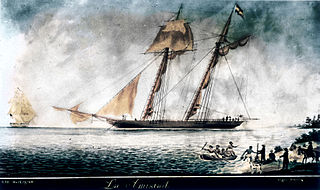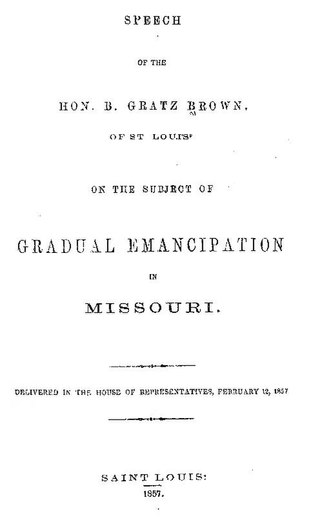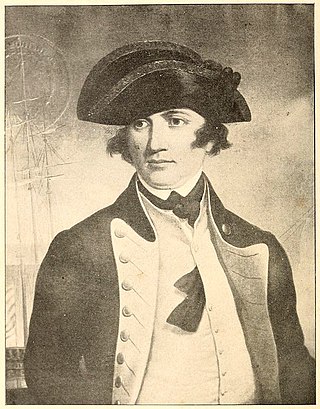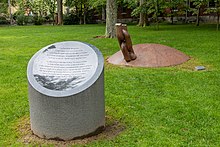
Abolitionism, or the abolitionist movement, is the movement to end slavery and liberate slaves around the world.

The Atlantic slave trade or transatlantic slave trade involved the transportation by slave traders of enslaved African people to the Americas. European slave ships regularly used the triangular trade route and its Middle Passage. Europeans established a coastal slave trade in the 15th century and trade to the Americas began in the 16th century, lasting through the 19th century. The vast majority of those who were transported in the transatlantic slave trade were from Central Africa and West Africa and had been sold by West African slave traders to European slave traders, while others had been captured directly by the slave traders in coastal raids. European slave traders gathered and imprisoned the enslaved at forts on the African coast and then brought them to the Americas. Some Portuguese and Europeans participated in slave raids. As the National Museums Liverpool explains: "European traders captured some Africans in raids along the coast, but bought most of them from local African or African-European dealers." Many European slave traders generally did not participate in slave raids because life expectancy for Europeans in sub-Saharan Africa was less than one year during the period of the slave trade because of malaria that was endemic in the African continent. An article from PBS explains: "Malaria, dysentery, yellow fever, and other diseases reduced the few Europeans living and trading along the West African coast to a chronic state of ill health and earned Africa the name 'white man's grave.' In this environment, European merchants were rarely in a position to call the shots." The earliest known use of the phrase began in the 1830s, and the earliest written evidence was found in an 1836 published book by F. H. Rankin. Portuguese coastal raiders found that slave raiding was too costly and often ineffective and opted for established commercial relations.

Triangular trade or triangle trade is trade between three ports or regions. Triangular trade usually evolves when a region has export commodities that are not required in the region from which its major imports come. It has been used to offset trade imbalances between different regions.

Slavery in the British and French Caribbean refers to slavery in the parts of the Caribbean dominated by France or the British Empire.

La Amistad was a 19th-century two-masted schooner owned by a Spaniard living in Cuba. It became renowned in July 1839 for a slave revolt by Mende captives who had been captured and sold to European slave traders and illegally transported by a Portuguese ship from West Africa to Cuba, in violation of European treaties against the Atlantic slave trade. Spanish plantation owners Don José Ruiz and Don Pedro Montes bought 53 captives in Havana, Cuba, including four children, and were transporting them on the ship to their plantations near Puerto Príncipe. The revolt began after the schooner's cook jokingly told the slaves that they were to be "killed, salted, and cooked." Sengbe Pieh unshackled himself and the others on the third day and started the revolt. They took control of the ship, killing the captain and the cook. Two Africans were also killed in the melee.

The history of slavery spans many cultures, nationalities, and religions from ancient times to the present day. Likewise, its victims have come from many different ethnicities and religious groups. The social, economic, and legal positions of slaves have differed vastly in different systems of slavery in different times and places.

Slavery in New Jersey began in the early 17th century, when the Dutch trafficked African slaves for labor to develop the colony of New Netherland. After England took control of the colony in 1664, Britain continued the importation of slaves from Africa. They also imported "seasoned" slaves from their colonies in the West Indies and enslaved Native Americans from the Carolinas.

The International Slavery Museum is a museum located in Liverpool, UK, that focuses on the history and legacy of the transatlantic slave trade. The museum, which forms part of the Merseyside Maritime Museum, consists of three main galleries which focus on the lives of people in West Africa, their eventual enslavement, and their continued fight for freedom. Additionally the museum discusses slavery in the modern day as well as topics on racism and discrimination.

Slavery was practiced in Massachusetts bay by Native Americans before European settlement, and continued until its abolition in the 1700s. Although slavery in the United States is typically associated with the Caribbean and the Antebellum American South, enslaved people existed to a lesser extent in New England: historians estimate that between 1755 and 1764, the Massachusetts enslaved population was approximately 2.2 percent of the total population; the slave population was generally concentrated in the industrial and coastal towns. Unlike in the American South, enslaved people in Massachusetts had legal rights, including the ability to file legal suits in court.

Market Square is a market square in Providence, Rhode Island. It is located at the intersection of present-day North Main Street and College Street at the base of College Hill. Market Square has historically functioned as a commercial, civic, and cultural locus of Providence.

The history of Brown University spans 260 years. Founded in 1764 as the College in the English Colony of Rhode Island and Providence Plantations, Brown is the seventh-oldest institution of higher education in the United States and the third-oldest institution of higher education in New England. At its foundation, the university was the first in the U.S. to accept students regardless of their religious affiliation. Brown's medical program is the third-oldest in New England while its engineering program is the oldest in the Ivy League.

In the United States, abolitionism, the movement that sought to end slavery in the country, was active from the colonial era until the American Civil War, the end of which brought about the abolition of American slavery, except as punishment for a crime, through the Thirteenth Amendment to the United States Constitution.

The Free African Union Society, founded in 1780 in Newport, Rhode Island, was America's first benevolent society for African Americans. Founders and early members included Prince Amy, Lincoln Elliot, Bristol Yamma, Zingo Stevens and Newport Gardner.

The role of slavery at American colleges and universities has been a recent focus of historical investigation and controversy. Enslaved Africans labored to build institutions of higher learning in the United States, and the slave economy was involved in funding many universities. Enslaved persons were used to build academic buildings and residential halls. Though slavery has often been seen as a uniquely Southern institution, colleges and universities in Northern states benefited from the labor of slaves. The economics of slavery brought some slave owners great wealth, enabling them to become major donors to fledgling colleges. Until the Civil War (1861–1865), slavery as an institution was legal and many colleges and universities utilized enslaved people and benefited from the slavocracy. In some cases, enslaved persons were sold by university administrators to generate capital, notably Georgetown University, a Catholic institution. In some parts of the nation it was also not uncommon for wealthy students to bring an enslaved person with them to college. Ending almost 250 years of slavocracy did not end white supremacy, structural racism, or other forms of oppression at American colleges and the legacy of slavery still persists in many establishments.

Gradual emancipation was a legal mechanism used by some U.S. states to abolish slavery over some time, such as An Act for the Gradual Abolition of Slavery of 1780 in Pennsylvania.

William Gregson was a British slave trader. He was responsible for at least 152 slave voyages, and his slave ships are recorded as having carried 58,201 Africans, of whom 9,148 died. Gregson was the co-owner of a ship called the Zong, whose crew perpetrated the Zong massacre.

The Sally (1764) was an 18th century Rhode Island brigantine slave ship launched from Providence and destined for the western-most coast of Africa. Like many voyages from the state at this time, the ship was charted by Nicholas Brown and Company, a merchant firm founded by the prominent Brown family. This same company, and the successful mercantile family, was the main benefactor in the foundation of Brown University in 1764. The story of The Sally rose to infamy upon return – and for centuries, thereafter – due to high mortality rates following a slave revolt and widespread health issues. Of the 196 captives on board, more than 109 were either murdered by captain, Esek Hopkins, and crew, died from diseases and starvation, or took their own lives. Within the state of Rhode Island, The Sally serves an important historical symbol of the atrocities of northern slavery, as well as the legacy of slave labor within prominent American institutions, namely Brown University.

Audley Clarke was a prominent banker, financier, and merchant from Newport, Rhode Island, known for his extensive involvement in the transatlantic slave trade as well his significant contributions to the local economy. Between 1790 and 1807, Clarke financed multiple slaving voyages yielding high profits and transporting hundreds of enslaved Africans to the Americas. Clarke also played a crucial role in the establishment of the Bank of Rhode Island, where he served as president for nearly three decades, and contributed land for the Newport Artillery Company’s armory. His legacy reflects both his impact on Newport's economic development and his controversial participation in the slave trade.


















